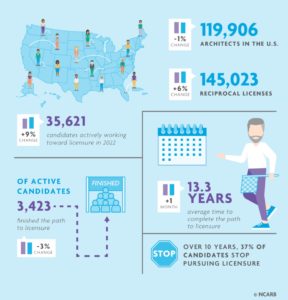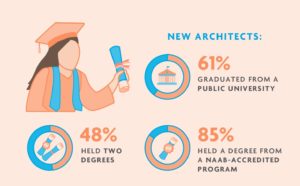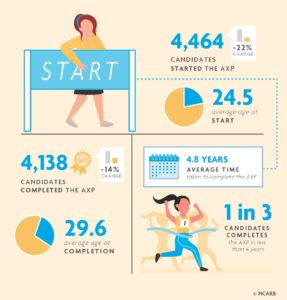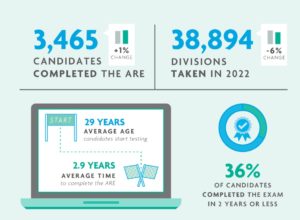NCARB BY THE NUMBERS 2023
Recently, NCARB released its annual “By the Numbers.” Today, we introduce you to NCARB by the Numbers. – https://www.ncarb.org/nbtn2023. It is well worth you review to learn more about the state of licensure.
As stated on the its website, the 2023 edition of NCARB by the Numbers, “the data reported in this publication was captured at the end of the 2022 calendar year, and much of the information gathered demonstrates growth and positive evolution: continued increases in the number of U.S.-licensed architects, higher demand for additional out-of-state licenses, increased diversity and gender parity at many career stages, and a slight decrease in the time it takes to earn an architecture license.”
More specifically, the data shared is on the following topics:
One of the first data points relates to the following:
Number or U.S. Architects Continues Upward Trend:
In 2022, there were 119,906 licensed architects across the 55 U.S. jurisdictions. Those architects also held approximately 145,000 reciprocal (out-of-state) licenses—a 6% increase compared to 2021—signaling the increased demand for professional mobility since the onset of the COVID-19 pandemic.
The number of candidates who made progress on the path to licensure in 2022 also rose by 9%, with more than 35,000 candidates reporting experience, taking the national licensing exam, or both. And at 13.3 years, the average time a candidate takes to complete these core requirements is about 2% longer than five years ago.
Now, here are some of the details from NCARB by the Numbers; for complete details, access the full report.
State of Licensure: https://www.ncarb.org/nbtn2023/state-of-licensure
The number of architects licensed in the United States remained relatively steady in 2022, decreasing by around 1% to 119,906—about 1,600 fewer than the number seen in 2021, according to data from NCARB’s annual Survey of Architectural Registration Boards.

Education: https://www.ncarb.org/nbtn2023/education
Earning a degree from an architecture program accredited by the National Architectural Accrediting Board (NAAB) is the most common path for candidates seeking architectural licensure in the United States. Data continues to show that, on average, licensure candidates with a degree from a NAAB-accredited program have greater success when taking the national licensing exam.

For more details on Education, access the NAAB Report on Accreditation in Architecture Education at the following: https://www.naab.org/accreditation/publications/
Experience: https://www.ncarb.org/nbtn2023/experience
In 2022, the average candidate took 4.8 years to complete the experience program. This is a one-month increase compared to 2021 and an approximate five-month increase compared to 2020. The average time to complete the AXP has been on the rise since the program launched in 2016.

Examination: https://www.ncarb.org/nbtn2023/examination
Required by all 55 U.S. jurisdictions, the Architect Registration Examination® (ARE®) 5.0 is a six-part exam taken by candidates seeking architectural licensure. Over 3,400 candidates completed the ARE in 2022, and the average candidate took 2.9 years to complete all six exams.

Demographics: https://www.ncarb.org/nbtn2023/demographics
Racial and ethnic diversity continued to increase in early career stages, especially for Asian and Hispanic or Latino candidates: over half of new Record holders and nearly half of candidates reporting experience identified as a race or ethnicity other than white. The candidate population also moved closer to gender parity, with women making up 50% of new Record holders and 49% of candidates reporting experience.
Inside NCARB: https://www.ncarb.org/nbtn2023/inside-ncarb
The proportion of new architects who started their NCARB Record in school (54%) was at a record high in 2022 and has been gradually increasing since 2018. The remaining 46% waited until after earning their degree to start an NCARB Record, a 6-percentage point decrease from 2018.
As you can see, there is a tremendous amount of valuable data in NCARB by the Numbers; as an aspiring architect, it is well worth your time to review and understand its implications.
Source: NCARB by the Numbers – https://www.ncarb.org/nbtn2023
